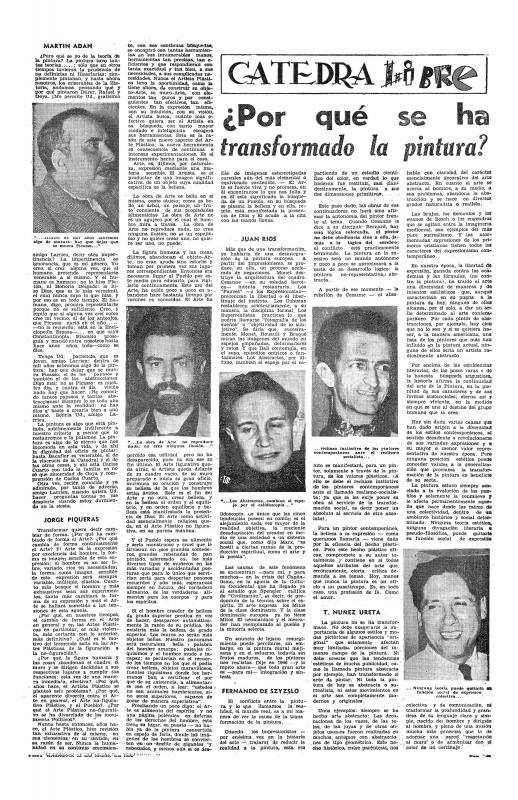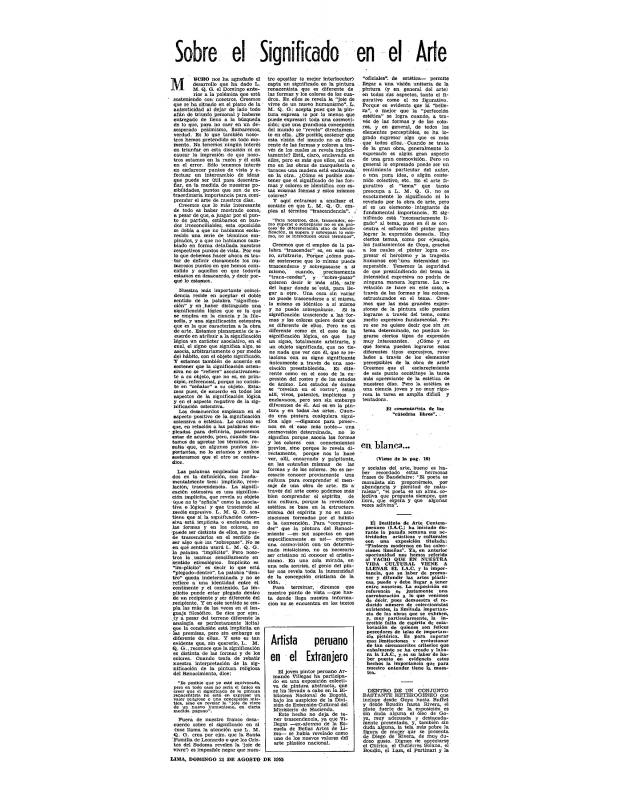The theorist and modernist architect Luis Miró Quesada comments on the first responses received from a number of artists and intellectuals to the survey about “classical” painting and “modern” painting that appeared in the Sunday supplement of El Comercio, a Lima newspaper. The author also briefly mentions the exhibition of works by Fred Stratton, an English watercolor painter who lives in Peru.
From May 29 to July 3, 1955 the “Cátedra Libre” section of the Sunday supplement of the Lima newspaper El Comercio published a survey about the aesthetic value of “modern” art as compared to “classical” art. [See the following articles in the ICAA digital archive, written by Cantuarias and published in El Comercio: “¿Es la pintura moderna respecto de la clásica, culminación o retroceso?” [As compared to classical painting, is modern painting an improvement on what came before or a step back?] (doc. no. 1137431); “¿Por qué se ha transformado la pintura?” [Why has painting changed?] (doc. no. 1137463) and (doc. no. 1137512); and “Pintura clásica y pintura moderna ¿ritmo acelerado o retorno a lo clásico?” [Classical painting and modern painting: speeding ahead or returning to the classics?] (doc. no. 1137531)]. The subject remained controversial after a year of almost continuous debate on the question of abstract art. A number of Peruvian intellectuals and artists replied to the survey, many of whom played leading roles in the discussions about non-figurative art that were taking place at that time, including the architect Luis Miró Quesada Garland (1914–94), the abstract painter Fernando de Szyszlo (b. 1925), the poet Alejandro Romualdo Valle (1926–2008), and the social-realist painter Alfredo Ruiz Rosas (1926–2002). According to Francisco Miró Quesada Cantuarias (b. 1918)—the lead writer of the section and editor of the supplement—the replies indicated an understanding of the differences and similarities between “modern” and “classical” art, but also reflected the polarization of local opinion that was radically split between supporters and critics of abstract art.
Despite the objective nature of his comments, Cantuarias also took a position when he identified “figuration” with “significance.” [See “Cátedra libre: en el Perú se reconoce el valor de la pintura moderna. Dos direcciones de importancia: pintura moderna y pintura significativa” (doc. no. 1137563)]. This prompted an immediate response from the main ideological champion of modernist art in Peru, Luis Miró Quesada Garland, who described abstraction as art that was both “significant” and transcendent on its own terms. On a theoretical level, however, the debate revealed ambiguities in many basic areas of the discussion, such as the actual concept of “abstract” [see the five articles by Garland “En blanca y negra” (doc. no. 1137595), (doc. no. 1137612), (doc. no. 1137661); (doc. no. 1137678); (doc. no. 1137712); and two others, both “En blanco y negra” (doc. no. 1137761) and “Sobre el significado del arte” (doc. no. 1137695). See also the articles by Cantuarias: “Sobre la influencia social en el arte” (doc. no. 1137629) and two others with the same title: “Sobre el significado del arte” (doc. no. 1226970) and (doc. no. 1137729)].















